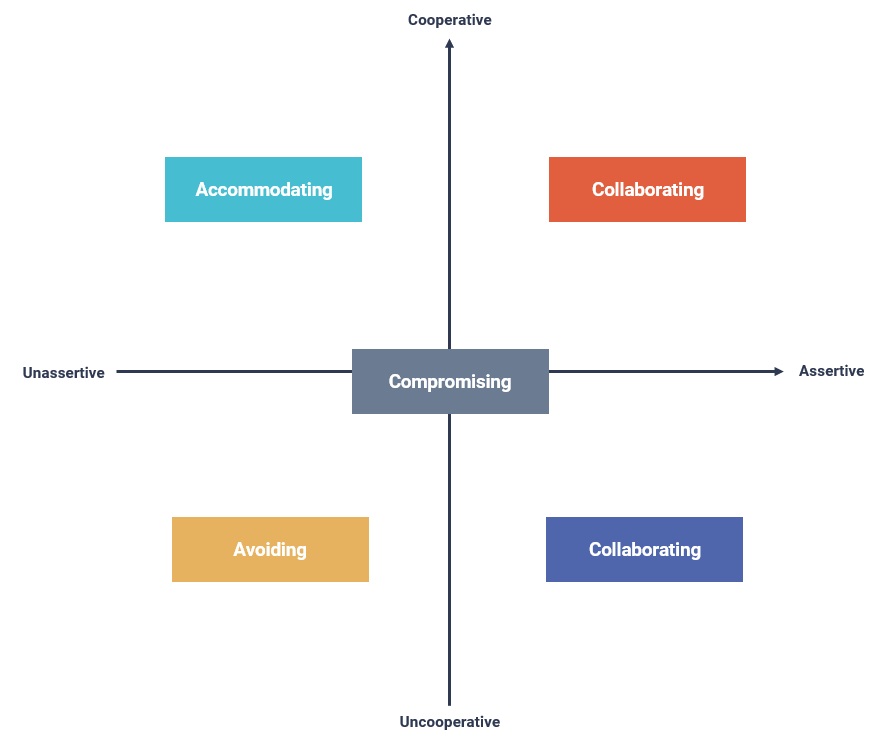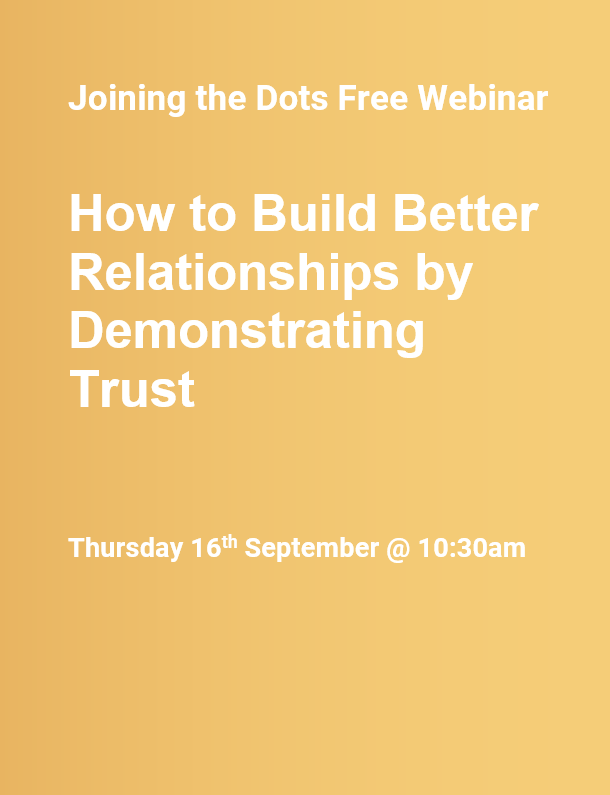Thursday 09 Sep 2021 Article
The Takeaway5 Simple Strategies to Deal with Confrontation and Conflict
Conflict Resolution 101
Part 2
#FreeWebinar #ConflictResolution #DifficultConversations #ThomasKilmannModel #PersonalDevelopment
The perfectly matched resource for this article...
[Free Webinar] How to Build Better Relationships by Demonstrating Trust
If you’re looking to improve trust in your workplace, our free ‘How to Build Better Relationships by Demonstrating Trust’ webinar at 10:30am on Thursday 16th September 2021 would be perfect for you.
Register for free!5 Simple Strategies to Deal with Confrontation and Conflict
Conflict in the workplace is inevitable but, if left unresolved, it can fester and affect team morale, working relationships, and productivity, so it’s crucial to address and resolve conflict as soon and as best as possible.
Researchers Kenneth Thomas and Ralph Kilmann studied how people manage conflict and observed that most people use one of five styles. In 1974, they then developed a fantastic model using these five approaches…
The Thomas-Kilmann Model
In this model, ‘conflict’ is defined as the outcome of two or more people’s views and opinions being contradictory and clashing. The Thomas-Kilmann Model identifies two ‘dimensions’ for resolving conflict; assertiveness and cooperativeness.
- Assertiveness is the extent to which you want to resolve conflict in a way that delivers the outcome that you desire.
- Cooperativeness is the extent to which you’re willing to resolve conflict in a way that delivers the outcome that someone else desires.
These two dimensions form axes x and y of the model, with 5 different approaches to conflict management plotted against them (as shown below).

Competing: Winning the Argument
The first approach on the Thomas-Kilmann Model is ‘Competing’; it is assertive and uncooperative. It only considers one’s own concerns and desired outcomes, ignoring others’ viewpoints and opinions. ‘Competing’ is a highly power-oriented mode of conflict resolution - people who ‘compete’ are simply trying to ‘win’ the argument/conflict even if they are in the wrong.
For example, if Helen in Sales and Rasheed in Operations had a disagreement because Helen gave Rasheed an incorrect date to schedule a meeting for but Helen was adamant that she gave the right date and that Rasheed was in the wrong, she would be ‘Competing’.
Very Quick Resolution: Make sure all parties actively listen to others’ perspective; this should give everyone a better understanding of the situation and will often help diffuse the conflict.
Accommodating: Complying to Others’ Opinions
The ‘Accommodating’ mode is unassertive and cooperative, and involves an element of sacrificing your own beliefs to accommodate others’ opinions. Often, being accommodating means doing something even if you don’t want to, to please others.
Going back to our example with Helen and Rasheed, if Rasheed then just went along with it and took the blame without voicing his side of the story, he would be accommodating.
Very Quick Resolution: Repeat what they have said back in their terms to ensure that they know that you understand the situation but then express why it may not work for you, e.g. the deadline is too soon, so that you can come to a mutual agreement.
Avoiding: Taking a Step Back from Conflict
‘Avoiding’ is unassertive and uncooperative where the individual doesn’t want to address neither their own nor others’ problems and perspectives - they avoid the conflict. While ignoring conflict altogether isn’t a good idea as it will then never get resolved, putting off addressing the conflict until a more suitable time can be a smart, diplomatic move.
If Helen refused to talk about what had happened and the issue at hand, she would be avoiding the conflict.
Very Quick Resolution: If somebody is avoiding conflict, understand that they likely have a valid reason and approach them at a more appropriate time.
{{ADVERT}}
Compromising: Reaching a Mutually Acceptable Solution
The last mode of conflict resolution is ‘Compromising’ which lies midway on the two axis. The goal of ‘Compromising’ is to find a mutually acceptable solution that satisfies everyone, but may not always be ideal. Compromising is often used when looking for a quick solution.
If Helen and Rasheed only agreed on a new date but didn’t put steps in place to prevent the issue from recurring, they would be compromising - reaching a quick solution, but not the best solution.
Very Quick Resolution: If a quick compromise is being made, consider how you could improve the solution to better satisfy both parties or how you could prevent the conflict from arising in the future. Look towards collaborating.
Collaborating: Developing a Mutually Beneficial Solution
On the opposite end of the spectrum, ‘Collaborating’ is both assertive and cooperative. ‘Collaborating’ involves working together to find a solution that benefits both parties and addresses everyone’s concerns.
If Helen admitted that she was in the wrong and worked together with Rasheed to find a new date to rearrange the meeting for, and they created a better handover process to prevent the issue from happening again, they would be collaborating as they would be coming up with the best possible solution.
Very Quick Solution: Make sure, with all parties, that it is a mutually beneficial solution, not just a mutually acceptable solution or worse.
Which Approach is Best?
As with most areas of leadership, there is no definitive right answer to this question. The balance between assertiveness and cooperation depends on many factors, including:
- Immediacy of the problem
- Your confrontation skills
- Your level of power
The table below suggests a few situations where it would be best to use either assertiveness or cooperation:

How to Minimise Conflict in the Workplace
As we mentioned right at the beginning of this article; conflict in the workplace is inevitable. However, one of the best ways of minimising conflict is by building strong working relationships where everyone trusts each other.
If you’re looking to improve trust in your workplace, our free ‘How to Build Better Relationships by Demonstrating Trust’ webinar at 10:30am on Thursday 16th September 2021 would be perfect for you.
This webinar, led by one of our training experts, covers:
- The meaning and importance of trust
- Increasing trust in the workplace
- How to demonstrate trust to build strong relationships
If increasing trust to help minimise conflict is something that you’re interested in, please click here or follow the link below to register for free.
https://ninedots.co.uk/Webinar/joiningthedots
---
Until next time...
[Free Webinar] How to Build Better Relationships by Demonstrating Trust
If you’re looking to improve trust in your workplace, our free ‘How to Build Better Relationships by Demonstrating Trust’ webinar at 10:30am on Thursday 16th September 2021 would be perfect for you.
Register for free!Missed an article?
More from Conflict Resolution 101
